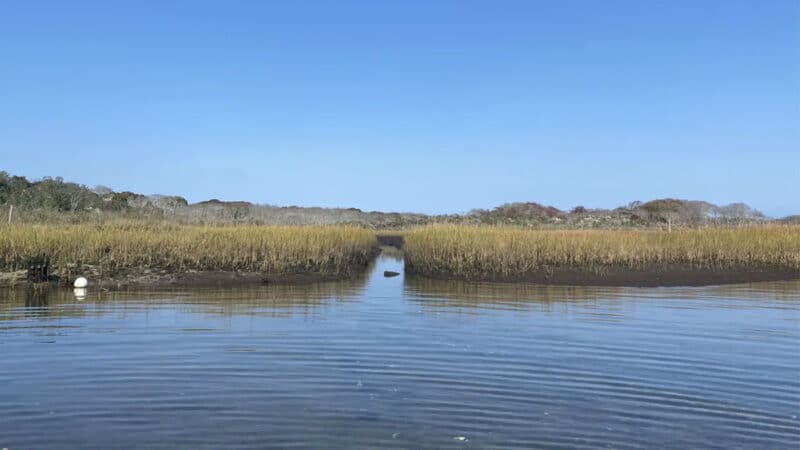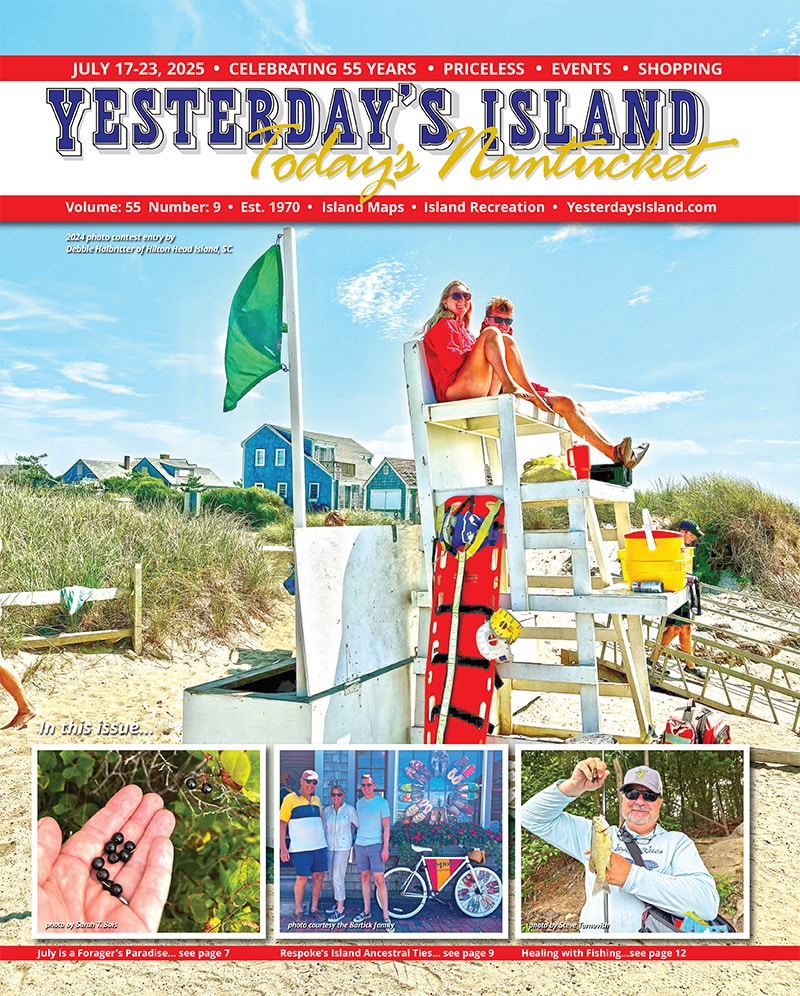by C. Oscar Olson
A culinary bounty of oceanic proportions awaits in the waters surrounding Nantucket. From the striper to the squid, the scallop to the sea bean, everyone can help in the harvest and enjoy these delicacies from the deep. There is one bivalve, though, that stands out from the sea of options all around us. And though we’ll never know who first thought the humble oyster was worth sampling, we are forever in their debt.
Oysters thrive in waters around the world, but it’s been said some of the best come from the cool, clean Atlantic around the shores of the northeastern United States. They are enjoyed grilled or baked, in soups, deep fried, or, most popularly, all on their own in the half-shell.
Over the past 100 years, global oyster numbers have fallen by an estimated 80%. That number is even higher in the United States, with an estimated 88% loss in oyster biomass over the same period. Northeast coast populations, the oysters we know and love, have been some of the hardest hit, with less than 6% of their once historic stocks remaining today. There are many reasons for this substantial loss, including over-harvesting, improper bed rehabilitation, habitat loss, and disease caused by pollution and poor water quality.
In response to worldwide population loss of such a special species, scientists and researchers have made significant efforts in restoring oyster reefs. The waters around Nantucket Island are pristine, making our many marshes, shallows, and coastal alcoves ideal for bringing oysters back from the brink.
In June of 2017 and 2018, the Oyster Restoration Project in Shimmo Creek was launched. This one-acre sub-tidal area consists of eight loose shell rows, making up more than 100,000 pounds of recycled oyster and quahog shell with seven rows of bare bottom in between. All the work was done by many volunteers, including local non-profit organizations, students, and community members. Oysters provide us with us much more than a refreshingly light lunch. They are filter feeders, meaning they take in water from their surroundings and extract particulate matter from it such food debris or krill. A single oyster can filter about 30 gallons of water a day, dramatically improving the water quality wherever they grow. In turn, this can serve to improve visibility, making it possible for sunlight to penetrate deeper to give grasses the sunlight they need to thrive, which work to clean the water and stabilize the sand even further.
Additionally, the dissolution of oyster shells can combat acidification: the ongoing decrease in the pH value of the Earth’s oceans. The most prominent cause is the uptake of carbon dioxide from the atmosphere, though there are some smaller scale influences as well, such as sewage runoff and the use of nitrogen-based fertilizers. The shells help to stabilize pH levels and protect other plant and animal species, and, along with oyster reefs, they also provide habitat for numerous types of fish, shellfish, and crustaceans, while acting as a shoreline buffer against high surf and erosion. The benefits of healthy oyster beds are almost endless.
Since the project was implemented in 2017, eelgrass has been found in areas of Shimmo where it wasn’t growing at all. Additionally, animal diversity has been climbing steadily since the restoration project began. During a 2016 survey, just 16 unique species were trapped and identified, a number that climbed to 29 just three years later. It is too soon to be sure, but these are positive signs things in our seas may be moving in the right direction.
The Town of Nantucket issues five licenses a year for the public to harvest wild oysters from our waters, but their elusive nature makes that more than enough. A keen eye may spot these hard-to-find wonders in Sesachacha Pond, on the jetties, in the harbor, or just off Easy Street Boat Basin. Fortunately for the rest of us, Nantucket has been a haven to oyster farmers since 1982.
Currently there are six growers who use either bottom culture or floating cages to grow oyster seed (juvenile oysters) purchased from a state-approved hatchery. One of them is Pocomo Meadow Oyster Farm, located on the south side of Pocomo Point near the mouth of Polpis Harbor: one of the oldest farms in operation on Nantucket. Twice a day the tide carries a rush water through the narrow channel connecting to Nantucket Harbor, and these oysters thrive in the fresh water bubbling up with nutrients from springs below the sand.
Oysters, much like the grapes used in wine making, can reflect the flavors found in the water in which they are grown. Even a difference of just a few miles can have a profound effect on the quality and character of an oyster. Flavor also fluctuates month to month and season to season. Simon Edwardes, founder and owner of Fifth Bend Oyster Farm, calls this likeness to terroir “Merroir.”
“My oysters have a nice, salty start with a sweet, smooth finish,” says Edwardes. This is very much due to the fact that they grow in the brinier waters at the Head of the Harbor. Fifth Bend Oyster Farm is is part of a 60-acre section out past Pocomo that has been set aside by the Department of Marine Fisheries for aquaculture, and Edwardes is one of five other farmers growing in that area of the harbor.
He began the application process in 2010, and it took about a year before Edwardes was able to get his operation off the ground and into the water. “The people involved were awesome,” he recalls, “these things just take time.”
According to Massachusetts law, a commercial oyster farm cannot be established in any area where other natural species exist. At Fifth Bend, the water is more than 20 feet deep, and the seafloor is nothing but mud, so Edwardes uses floating gear to grow above the bottom. “There’s not much else down there other than maybe a lost conch,” Edwardes laughs, “and it would be a miracle if something did show up, given the state of the harbor.”
Of English descent and a native of Kenya, Edwardes moved to the island in 2004. He often employs his two sons, 14- and 15-years-old, to help with the labor when they’re free from school. “I hire other kids when I can too, college kids as well. It’s a fairly physical job, it certainly better suits younger people.” On a good day, Edwardes and his team can haul upwards of 200 nets out of the water. But the work never ends: “It’s like painting a bridge. By the time you finish on one end you’ve got to start back on the other.” The bags need to be emptied of oysters to reduce their density and clean algal growth regularly to ensure they thrive under the best conditions.
Almost the entire local oyster harvest, about 95% of it, is served exclusively in Nantucket restaurants. Last year, every eatery on-island committed to selling only locally grown oysters, helping local growers during a particularly challenging year. It is estimated that an astounding 300,000+ oysters are enjoyed on Nantucket every single year.
Each farmed oyster starts out ranging from about the size of a grain of quinoa to a kernel of corn, and spends its first two years of life growing in a large mesh bag suspended in the sea. Once they’ve reached three inches long, they’re caged, or, in Pocomo Meadow’s case, set free in the marsh as “free range oysters.” Once mature, they’re pulled up or raked and harvested by hand, put on ice, and quickly served up inside of 36 hours at some of Nantucket’s finest eateries.
While the oysters are hunkered down under our waters, hard at work helping to keep our harbor clean, there’s are some things that the public can do to ensure they continue to flourish. Nitrogen plays an important role in the air as it does in our oceans, but too much of it can cause serious problems. When levels in the water start to climb, an inevitable increase in algae blooms cause oxygen levels to fall.
Globally, oceans have lost around 2% of dissolved oxygen since the 1950s. This might not seem like much, but the consequences are apparent all around us. On a larger scale, warming oceans hold less oxygen, making it more buoyant than cooler water. This leads to reduced mixing of oxygenated water near the surface with deeper waters, which naturally contain less oxygen. Warmer water also raises oxygen demand from living organisms. And as a result, less breathable oxygen is available for marine life.
Little adjustments in our everyday lives can make a big difference. Nitrogen based fertilizers used on lawns and in gardens will eventually find its way to the water, as will sewage runoff and waste from boaters. Discontinuing the use of these products and being more mindful of our waste will help mitigate the problems in our harbors and those posed by our warming oceans.



